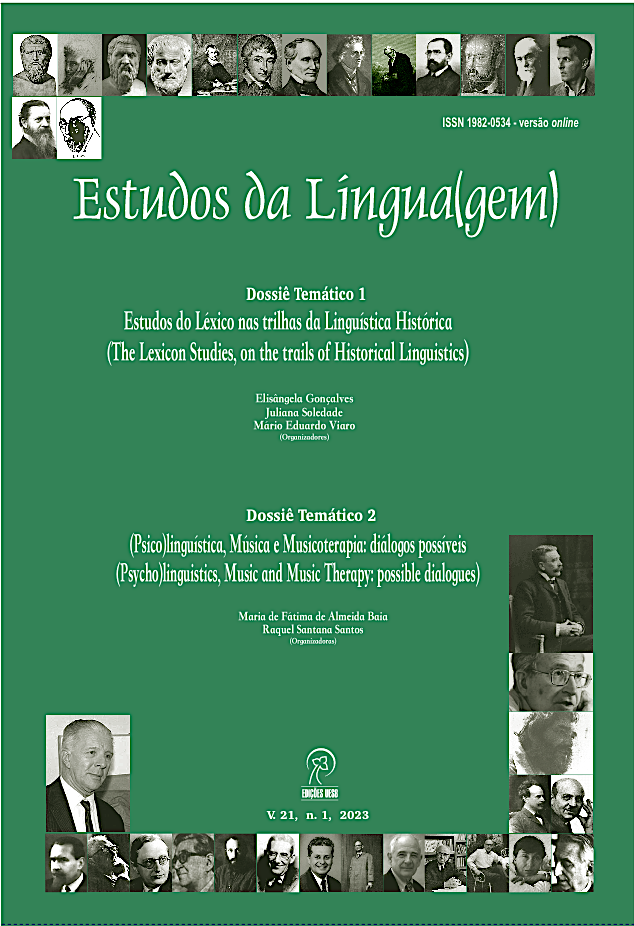O canto infantil e traços de seu desenvolvimento: complementaridade entre estudos e teorias (Children's singing and traces of its development: complementarity between studies and theories)
DOI:
https://doi.org/10.22481/el.v21i1.13374Palavras-chave:
Canto infantil; Cognição musical; Complementaridade.Resumo
Para tratar alguns aspectos do canto infantil e sua relação com aspectos cognitivos, seguimos os seguintes passos neste artigo: (1) capacidade musical é apresentada sob três visões diferentes e não excludentes entre si; (2) estudos mais recentes sobre desenvolvimento musical são resenhados com foco no canto e (3) por fim, aborda-se o canto espontâneo de crianças. O canto infantil deve ser objeto de estudo promissor para se entender a relação entre percepção do ambiente musical e a produção canora do indivíduo na infância; e como essas percepção e produção refletem o meio musical e podem ser brechas para se entrever aspectos da cognição musical.
Downloads
Referências
BIGAND, E., DELBÉ, C., POULIN-CHARRONNAT, B., LEMAN, M., TILLMANN, B. Empirical evidence for musical syntax processing? Computer simulations reveal the contribution of auditory short term memory. Frontiers in Systems Neurosciences, v. p. 94, jun. 2014. https://doi.org/10.3389/fnsys.2014.00094
BIGAND, E; POULIN-CHARRONNAT, B. Are we “experienced listeners”? A review of the musical capacities that do not depend on formal musical training. Cognition, v. 100, p. 100–130, 2006. doi: 10.1016/j.cognition.2005.11.007
CORBEIL, M., TREHUD, S. E.; PERETZ I. Speech vs singing: Infants choose happier sounds. Frontiers in Psychology, v. 4, p. 372, 2013.
COSTA GIOMI, E.; BENETTI, L. Through a baby’s ears: Musical interaction in a family community. International Journal of Community Music, v. 10, issue 3, p. 55-69. 2017. doi: 10.1386/ijcm.10.3.289_1
COSTA GIOMI, E.; BENETTI, L. Home musical environment and singing development in infancy. In: RUSSO, A.; ILARI, ILARI, B.; ANNABEL, J. COHEN. (eds.). The Routledge Companion to Interdisciplinary Studies in Singing Volume I: Development. 1ed. New York: Routledge Taylor & Francis Group, 2020. p. 189-199.
FALK, S.; TSANG, C. D. The role and functions of infant-directed singing in early development. In: RUSSO, A.; ILARI, ILARI, B.; ANNABEL, J. COHEN. (eds.). The Routledge Companion to Interdisciplinary Studies in Singing Volume I: Development. 1ed. New York: Routledge Taylor & Francis Group, 2020. p. 179-188.
FEDORENKO, E.; PATEL, A. D.; CASASANTO, D.; WINAWER, J.; GIBSON. E. Structural integration in language and music: Evidence for a shared system. Memory & Cognition, v. 37, p. 1-9, 2009.
FONSECA, M. B. P. A produção musical da criança na primeira infância. Monografia de Especialização em Educação Musical. Escola de Música da Universidade de Minas Gerais, 1986.
GUDMUNDSDOTTIR, H.; TREHUB, S. Adults’ recognize toddler' s song renditions. Psychology of Music, v. 46, p. 281-291, 2018.
KESSEN, W.; LEVINE, J.; WENDRICH, K. A. The imitation of pitch in infants. Infant Behavior and Development, v. 2, p. 93-99, 1979.
Patel A. D. Music, Language, and the Brain. Oxford: Oxford University Press, 2008.
LARGE, E. W. Neurodynamics of Music. In: JONES, M. R. s et al. (eds.) Music Perception, Springer Handbook of Auditory Research 36, 2010a. p. 201-226. doi 10.1007/978-1-4419-6114-3_7
LARGE, E. W. A dynamical systems approach to musical tonality. In: HUYS, R.; JIRSA, V. (Eds.), Nonlinear dynamics in human behavior. New York: Springer, 2010b. p. 193-211. doi: 10.1007/978-3-642-16262-6_9
LARGE, E.; KIM, J.; FLAIG, N. N.; BHARUCHA, J.; KRUMHANSL, C. L. A neurodynamic account of music tonality. Music Perception, Vol. 33, no. 3, p. 319-331, 2016. doi: 10.1525/mp. 2016.33.3.319
LERDAHL, F.; JACKENDOFF, R. A generative theory of tonal music. Cambridge: MIT Press, 1983.
MEHR, S. A.; SINGH, M.; KNOX, D.; KETTER, D. M.; PICKENS-JONES, D.; ATWOOD, S.; LUCAS, C.; JACOBY, N.; EGNER, A. A.; HOPKINS, E. J.; HOWARD, R. M.; HARTSHORNE, J. K.; JENNINGS, M. V.; SIMSON, J.; BAINBRIDGE, C. M.; PINKER, S.; O'DONNELL, T. J.; KRASNOW, M. N.; GLOWACKI, L. Universality and diversity in human song. Science, Vol 366, Issue 6468, 2019. Downloaded from http://science.sciencemag.org/ on November 28, 2019.
PAIVA, A.; MACHADO, A.; PARIZZI, B. O canto espontâneo como indicador do desenvolvimento musical de uma criança de quatro anos. Anais do 3º Nas Nuvens... Congresso de Música, 01 a 08 de dezembro de 2017, UFMG, UEMG e King’s Brazil Institute, p. 82-94, 2017. Acessado: 3º Nas Nuvens… Congresso de Música: Anais (2017) – Nas nuvens… Congresso de Música (ufmg.br)
PARIZZI, M. B. A música espontânea da criança como manifestação de seu estágio cognitivo. In: DOTTORI, M.; ILARI, B., SOUZA, R. Anais do 1º. Simpósio Internacional de Cognição e Artes Musicais. Curitiba: Deartes –UFPR, 2005. p. 379-385.
PARIZZI, M. B. O desenvolvimento da percepção do tempo em crianças de dois a seis anos: um estudo a partir do canto espontâneo. Tese (Doutorado em Ciências da Saúde). Faculdade de Medicina, Universidade Federal de Minas Gerais. Belo Horizonte, 2009.
PATEL, A. D. Language, music, and the brain: a resource-sharing framework. In: REBUSCHAT, P.; ROHRMEIER, M.; HAWKINS, J.; CROSS, I. (Eds.), Language and Music as Cognitive Systems. Oxford: Oxford University Press, 2012. p. 204-223.
RAPOSO DE MEDEIROS, B.; CABRAL, J. P.; MEIRELES, A.; BACETI, A. A comparative study of fundamental frequency stability between speech and singing. Speech Communication, v. 128, p. 15-23, 2021. https://doi.org/10.1016/j.specom.2021.02.003
RUSSO, F. A.; ILARI, B.; COHEN, A. J. Singing, development, interdisciplinarity and the biopsychosocial framework. In: RUSSO, A.; ILARI, ILARI, B.; ANNABEL, J. COHEN. (eds.) The Routledge Companion to Interdisciplinary Studies in Singing Volume I: Development. 1ed. New York: Routledge Taylor & Francis Group, 2020. p. 1-14.
STADLER ELMER, S. Human singing: Towards a developmental theory. Psymusichology: Music, Mind and Brain, v. 21, issue 1e 2, p. 13-30, 2012. Doi 10.1037/h0094001
STADLER ELMER, S. (2020). From canonical babbling to early singing and its relation to the beginnings of speech. In: RUSSO, A.; ILARI, ILARI, B.; ANNABEL, J. COHEN (eds.) The Routledge Companion to Interdisciplinary Studies in Singing Volume I: Development. 1ed. New York: Routledge Taylor & Francis Group, 2020. p. 25-38.
Sloboda, J. A. A mente musical: psicologia cognitiva da música. Trad. De Beatriz Ilari e Rodolfo Ilari. Londrina: EDUEL, 2008.
VAN DER SCHYFF, D.; SCHIAVO, A. WALTON, A., VELARDO, V. CHEMERO, A. Musical creativity and the embodied mind: Exploring the possibilities of 4E cognition and dynamical systems theory. Music & Science, v. 1, p. 1-18, 2018. doi.org/10.1177/2059204318792319
TREHUB, S.; RUSSO, F. A. (2020). Infant-directed singing from a dynamic multimodal perspective. In: : RUSSO, A.; ILARI, ILARI, B.; ANNABEL, J. COHEN (eds.) The Routledge Companion to Interdisciplinary Studies in Singing Volume I: Development. 1ed. New York: Routledge Taylor & Francis Group, 2020. p. 249-261.
WARLAUMONT, A. S.; RICHARDS, J. A.; GILKERSON, J.; OLLER, D. K. A social feedback loop for speech development and its reduction in autism. Psychological Science, v. 25, issue 7, p. 1314-1324, 2014. doi.org/10.1177/0956797614531023
Downloads
Publicado
Como Citar
Edição
Seção
Licença

Este trabalho está licenciado sob uma licença Creative Commons Attribution 4.0 International License.
Autores que publicam em Estudos da Língua(gem) concordam com os seguintes termos:
Estudos da Língua(gem) mantém os direitos autorais das contribuições publicadas e disponibiliza seu conteúdo gratuitamente por meio do portal. Autores têm permissão e são estimulados a publicar e distribuir seu trabalho online em repositórios institucionais ou na sua página pessoal, com reconhecimento de autoria e créditos de publicação inicial nesta revista, indicando endereço online.






